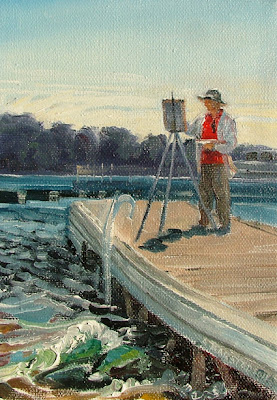Painting the Painter (oil on canvas 5 x 7 in)
10 September in the afternoon finds me painting a painter - Phil Chadwick is painting from the dock, facing south. Behind him are the docks of the cruise boats. Small waves lap against the shining algae-streaming rocks at the base of the dock, washed by bigger waves with each boat wake that arrives. Behind me is the western flank of Fish Rock, with a depression atop it that's filled with water from the largest waves, warmed by the sun like a outdoor bathtub. This, I'm told, is where parents watch little children splash while older children fish from the dock and teens jump from the high shoulder of the great granite boulder.
Other artists, on the lawn behind us, paint a tug boat that is moored at one of the little docks that jut out from the shore, and more are standing at their easels here and there through the town, and out painting on some of the "Thousand Islands" that makes the place where the granite bedrock of the Frontenac Arch crosses the St Lawrence River so popular with residents, cottagers, and visitors.
Sunday, 11 September:
It was a grand weekend for plein air painters in Rockport, with lots of camaraderie, shared experience and inspiration, good food, and evening presentations by our Weatherman painter Phil Chadwick. After everyone left on Sunday afternoon I investigated the protected water of the quay between the dock and the shore near Fish Rock, finding no live fresh water mussels, but only a few very old white shell fragments visible from the dock along shore, and the only living Zebra Mussels I found were attached to the undersides of rocks in rows and clusters, none larger than 1cm. They lie against each other like flakes of translucent chert, with amphipods jostling each other to squeeze between them away from the light and air. There were Caddis Fly larval tubes, a 3cm long wooden one and a smaller one of coarse sand - and an irregular sort of network of ivory coloured spongy colony of some kind, perhaps a fresh water sponge, growing on the surface in a diameter of 1cm and a thickness of 3 - 4 mm. Out of the water it showed short bristles all over its surface that were noticeable because they glistened in the sun. They didn't retract when I touched them.
The initial boom of Zebra Mussels around 1990 seems to have wiped out the native mussels here on the shore of the St Lawrence - and now the population of Zebras has subsided, as often happens to invaders after a few years as local predators (in this case muskrats, diving ducks, and fish) learn to eat them.
No crayfish under rocks I turned at the base of the dock in water to the height of my boots, and no crayfish on the other side of the isthmus of lawn that leads to the dock and to Fish Rock. It was sandy with rocks there too, and clumps of tangled olive green branching, fibrous weed as the water gets deeper toward the moored tug boat that several people painted. I collected two conical aquatic operculate snails which were clinging to the side of a rock in the shallows. No drift of note - just a furze of tree roots that looked as if it might be drift. It catches a few old Zebra Mussel valves.




Touching... I am honoured to be the subject of one of Aleta's creations. She captured how I stand when I paint - I think I was in "the zone".
ReplyDeleteI liked the way the sun was shining through your shirt tail. I was also tempted to paint your grin - every time you noticed me, I could see a broad flash of white teeth in your face. But I painted you looking at your painting, not at me...
ReplyDelete